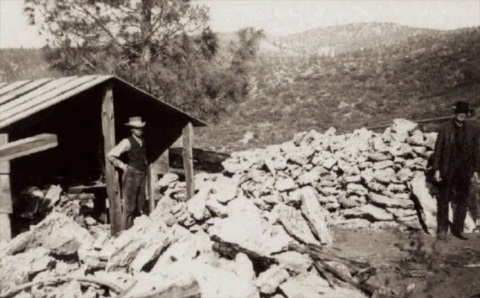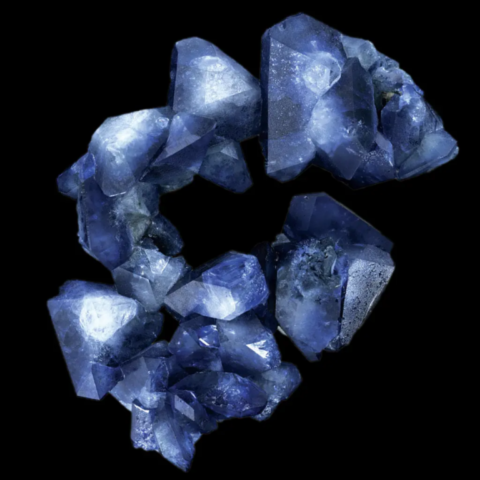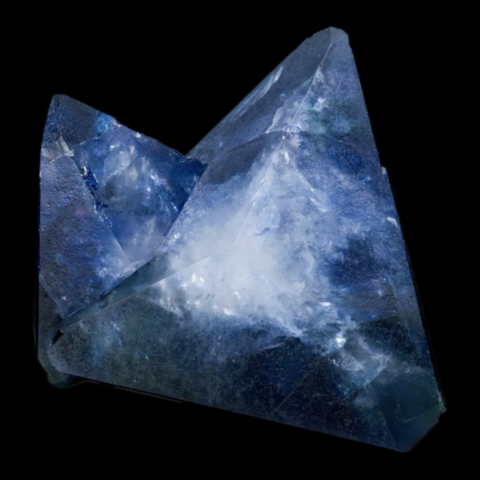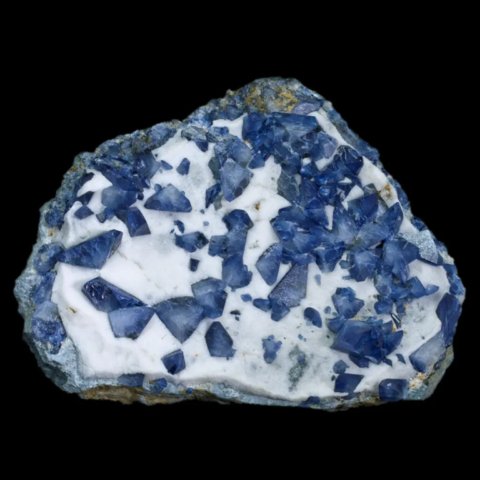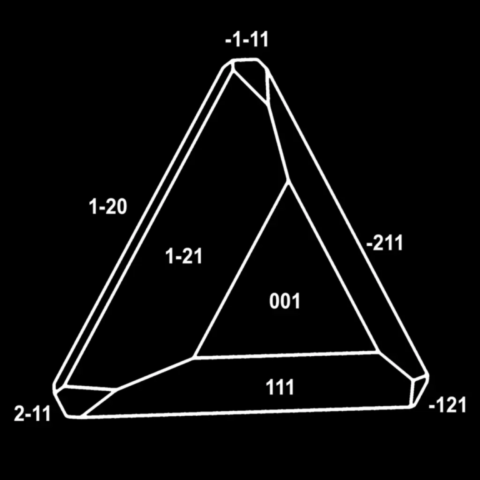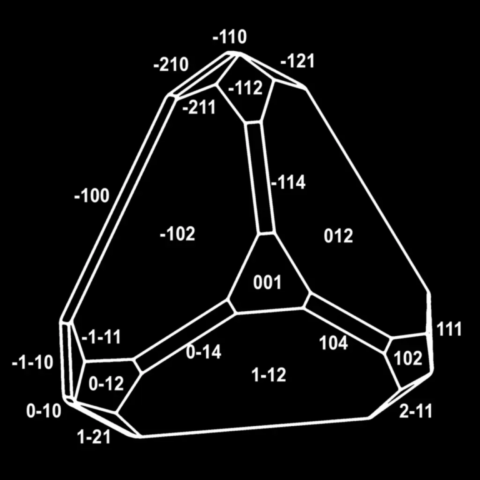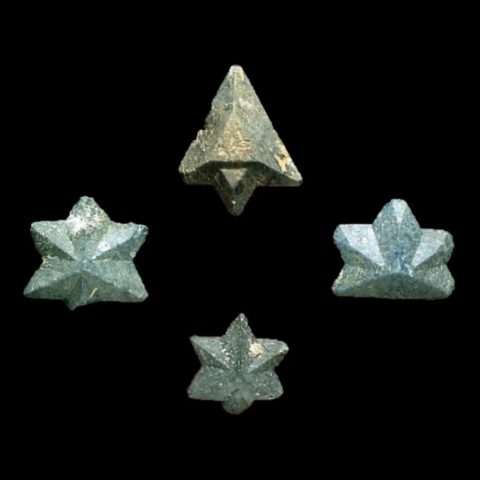Benitoite from New Idria District, California
Benitoite is an extremely rare mineral, recognizable by its deep blue color and exceptional luster. It is mined significantly in only one place in the world, the Benitoite Gem Mine in the New Idria District, located in San Benito County, California. Since its discovery in 1907, it has fascinated gemologists and collectors with its unique optical properties and extreme rarity. This article explores in depth the history, geology, physical characteristics, and methods of extraction and preparation of this mineralogical rarity.
Photo : Benitoite from Benitoite Gem Mine, California, USA © Rémi Bornet
Discovery history
Benitoite was discovered in 1907 in the Diablo Range Mountains of California. Its initial identification is attributed to J. M. Couch, a prospector who was traveling the region in search of new deposits. While exploring rock outcrops in the area, he noticed deep blue crystals that he initially mistook for sapphire. Shortly thereafter, he sent samples to the University of California for further analysis.
It was mineralogist George Louderback who, in 1909, confirmed that it was not sapphire but a new mineral species, which he named benitoite after the San Benito County where it was discovered. He also determined that this new mineral had a unique crystal structure and a light dispersion superior to that of diamond, giving it a remarkable brilliance. This discovery quickly attracted the interest of collectors and scientists, who recognized benitoite as an exceptional mineral.
Mining of the deposit began shortly after this identification with the creation of the Dallas Mining Company. However, the extraction conditions quickly proved difficult. The benitoite was often embedded in a natrolite matrix, which complicated the recovery of the crystals without damaging them. In 1912, faced with technical challenges and lack of profitability, commercial mining ceased and the site was abandoned.
Over the following decades, several attempts at revival were made, but it was not until the 1960's that William Forrest and Elvis Buzz Gray implemented more efficient processes to extract benitoite while preserving its most remarkable crystals. In 1987, they officially became the owners of the mine and continued to operate the site using modern methods of extraction and processing of specimens. Today, the mine remains the only significant source of benitoite in the world, although its exploitation has become increasingly limited due to the depletion of accessible resources. It remains a popular destination for gemstone enthusiasts. Still in operation, it welcomes the public and offers an immersive gem-hunting experience, ideal for families, collectors and enthusiasts. Visitors can explore the site and try to discover this rare mineral.
Photo : Archive of the mining of blocks of this benitoite natrolite in the 1930's © Collector's Edge
The geological context
The New Idria district benitoite deposit is closely related to ophiolites, geological formations that represent pieces of the oceanic crust and upper mantle obducted onto the continent during tectonic processes. Ophiolites are composed mainly of peridotites, gabbros, basalts and marine sediments, and are the result of the subduction of an oceanic plate under a continental plate, followed by the obduction of these rocks onto the continent. In the case of New Idria, serpentinite is a metamorphosed peridotite that was obducted to the surface during the collision of tectonic plates.
The blueschists present in the region come from the metamorphic transformation of basic rocks (such as basalts and gabbros) and marine sediments of the oceanic crust. These rocks have undergone high-pressure, low-temperature metamorphism in subduction zones, and are therefore products resulting from the metamorphism of the oceanic crust under extreme conditions. Blueschists are rich in specific minerals such as glaucophane and lawsonite, which indicate pressure and temperature conditions characteristic of the blueschist facies.
The formation of benitoite in these blueschists is linked to the circulation of hydrothermal fluids enriched in barium and titanium. Barium comes from basaltic and gabbroic rocks, which naturally contain it. During the alteration of blueschists, these elements are released and transported by hydrothermal fluids that infiltrate the fractures of the rocks. Titanium, on the other hand, comes from the destabilization of titanium-rich minerals, such as ilmenite, present in basalts and peridotites. When these rocks are subjected to intense metamorphism, titanium is mobilized in hydrothermal fluids and precipitates in the cavities of the blue schists, contributing to the crystallization of benitoite in the presence of natrolite.
Thus, benitoite is formed in unique geological conditions, where the combination of an ophiolitic environment, the metamorphism of blue schists and then the circulation of hydrothermal fluids enriched in barium and titanium allows the crystallization of this rare mineral. Natrolite, which often surrounds benitoite crystals, plays a protective role by preserving them from subsequent geological alterations. In addition to benitoite, the deposit contains other rare minerals, such as neptunite and joaquinite, which testify to the particular chemical conditions that prevailed during the formation of this gem, making this site an exceptional example of the geological processes associated with ophiolites.
The different mines
The different Benitoite mines are distinguished by their geology and the nature of their mineralization. The Benitoite Gem Mine is located on a low hill. Blue schist, often altered, is the main host of the Benitoite, which occurs as automorphic crystals up to 5.6 cm in diameter. Historical exploitation has mainly concerned the central section of the deposit, but in 1997, a new mineralized zone was discovered in the western part, buried under 10 meters of unconsolidated material. The Benitoite formed in a hydrothermally altered zone, where it is associated with natrolite, neptunite and various accessory minerals.
Other sites, such as the Junnila Claim, located 7 km northwest of the Benitoite Gem Mine, also contain Benitoite. Here, the blueschist is altered and cut by vertical fractures filled with a calcium-rich mineral assemblage including thomsonite and pectolite. Benitoite crystals are typically translucent and tabular, sometimes up to 2.6 cm. The Mina Numero Uno Claim, located further north, has similar but more dispersed mineralization, with crystals up to 5 mm in geodes lined with albite and amphibole.
The Victor Claim, approximately 9.2 km northwest of the main mine, is characterized by blueschists surrounded by serpentinite and containing small, colorless benitoite crystals in thin veins parallel to the foliation. Finally, the Santa Rita Peak property, located 1.2 km north of the Benitoite Gem Mine, shows outcrops of altered blue schist cut by natrolite veins, where microscopic analyses have revealed the presence of benitoite.
Properties and crystallography
Benitoite is predominantly blue to blue-violet, although some rare varieties can be colourless, pink or orange after heat treatment. The intense blue of benitoite is attributed to the presence of titanium in its crystal structure. It also exhibits marked dichroism, an optical phenomenon that produces a variation in colour depending on the angle of observation. Depending on the orientation of the crystal, it can appear deep blue, pale blue or almost colourless.
Another fascinating aspect of benitoite is its extremely high dispersion (0.044), higher than that of diamond (0.028). This property gives it exceptional brilliance and spectacular plays of light, with colourful flashes clearly visible under strong light. This high dispersion is due to the gem’s refractive index, which varies between 1.757 and 1.804. The higher the refractive index, the more light is broken down into its different colors, producing an intense "fire" effect when well cut.
On the Mohs scale, benitoite has a hardness of between 6 and 6.5, making it strong enough to be used in jewelry, although more fragile than sapphire or spinel. Unlike minerals such as diamond or topaz, it does not have a well-defined cleavage, but it remains relatively brittle due to its crystalline structure, which complicates its faceting. Its work requires great expertise on the part of lapidaries, who must avoid internal fractures and maximize its light dispersion.
Benitoite crystals have a distinctive triangular shape, often described as pseudo-hexagonal, which makes them immediately recognizable. They frequently contain inclusions of associated minerals, such as neptunite, joaquinite and actinolite, which can influence the colour of the crystal, sometimes giving it a slightly greenish hue. Although these inclusions are sometimes perceived as imperfections, they are distinctive markers of the natural origin of benitoite. Twins in the form of 6-pointed stars are known but extremely rare and always opaque. Finally, benitoite exhibits a strong blue fluorescence under short-wave UV, which is another valuable indicator for the identification of this rare gem.
Preparation of mineralogical specimens
Benitoite crystals are often coated with natrolite, a mineral of the zeolite family that forms around the crystals in the cavities of blue schists. To highlight the crystals, it is necessary to remove this natrolite matrix without damaging the underlying benitoite.
The release process is mainly based on the use of dilute hydrochloric acid. Since natrolite is soluble in strong acids, it gradually dissolves when immersed in a controlled solution. This operation requires careful control of the pH in order to avoid the precipitation of silica gel, it dissolves the matrix without affecting the benitoite, which is resistant to acids. The dissolution, very slow (several weeks), occurs without gas release. Once the natrolite is dissolved, the specimens are carefully rinsed with distilled water to remove any acid residue and preserve their natural shine.
A prestigious jewelry stone
Rare and dazzling, benitoite is an exceptional gemstone that occupies a privileged place in the world of fine jewelry. Its intense blue, ranging from sapphire blue to purplish blue, combined with a light dispersion greater than that of diamonds, gives it an unequaled brilliance. This rarity is reinforced by its only significant deposit, located in California, it was also declared the official gem of the State in 1985. It is a precious stone highly coveted by collectors and jewelers.
With a hardness of 6 to 6.5 on the Mohs scale, it requires meticulous faceting to reveal all its brilliance without altering its fragile structure. Jewelry set with Benitoite, often mounted in white gold or platinum to enhance their luminous reflections, are exceptional pieces. Due to its rarity, its price can reach $8,000 to $10,000 per carat for exceptional specimens, although gem-quality stones typically sell for $3,000 to $6,000 per carat.
Large crystals are extremely rare. The majority of faceted Benitoite weigh less than one carat, and stones over 2 carats are considered exceptional. The world record for the largest known faceted Benitoite is held by a 15.42-carat specimen, an extraordinary piece that testifies to the extreme rarity of rough crystals of sufficient size for such a gemstone. Due to its exclusive nature and the progressive depletion of exploitable resources, Benitoite is today a luxury stone, a symbol of rarity and timeless elegance.
Right photo : 0.71 ct faceted Benitoite from Dallas Gem Mine, California, USA © Heritage Auctions
Conclusion
Benitoite is an exceptional gemstone, both for its beauty and its rarity. Its history, its unique geological formation and its gemmological properties make it a collector's gem prized by enthusiasts and investors. With the scarcity of exploitable resources, it remains one of the most exclusive stones in the world and its appeal continues to grow among connoisseurs.
References :
ANTHONY J.W., BIDEAUX R.A., BLADH K.W., NICHOLS M.C. (1995) - Handbook of Mineralogy, Vol. 2: Silica, Silicates; Part 1. Mineral Data Publishing, Tucson, AZ.
ARNOLD R. (1908) - Notes on the occurrence of the recently described gem mineral, benitoite. Science, Vol. 27, No. 686, pp. 312–314.
AUSTIN D.H. (1988) - The Benitoite Story. Independently published, 80 pp.
BRADLEY W.W., HUGUENIN E., LOGAN C.A., WARING C.A. (1917) - Gems. Mines and Mineral Resources of the Counties of Monterey, San Benito, San Luis Obispo, Santa Barbara, Ventura. California State Mining Bureau, San Francisco, CA, pp. 42–43.
COLEMAN R.G. (1957) - Mineralogy and petrology of the New Idria district, California. Ph.D. dissertation, Stanford University, Stanford, CA.
COLEMAN R.G. (1961) - Jadeite deposits of the Clear Creek area, New Idria district, San Benito County, California. Journal of Petrology, Vol. 2, pp. 209–247.
LOUDEBACK G.D. (1907) - Benitoite, a new California gem mineral. University of California, Department of Geological Sciences Bulletin, Vol. 5, pp. 149–153.
LOUDEBACK G.D. (1909) - Benitoite, its paragenesis and mode of occurrence. University of California, Department of Geological Sciences Bulletin, Vol. 5, pp. 331–380.
LAURS B.M., ROHTERT W.R., GRAY M. (1997) - Benitoite from the New Idria District, San Benito County, California. Gems & Gemology, Fall 1997, Vol. 33, No. 3.
WISE W.S., MOLLER W.P. (1995) - Geology and mineralogy of the New Idria district, San Benito and Fresno Counties, California. Rocks and Minerals, Vol. 70, No. 1, pp. 27–35.


